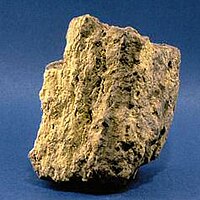
Photo from wikipedia
Abstract Uranium deposits are diverse as a result of their formation in a wide variety of geological environments. However, the source of the uranium within these deposits is difficult to… Click to show full abstract
Abstract Uranium deposits are diverse as a result of their formation in a wide variety of geological environments. However, the source of the uranium within these deposits is difficult to identify and as a result it is usually poorly understood. This study focuses on the hydrothermal Sanqiliu and Sanqisi uranium deposits, both of which formed within NE–SW striking shear zones that cross-cut the Sanfang batholith and low-grade metasedimentary rocks of the Motianling district, southern China. The deposits contain vein-hosted pitchblende–quartz–pyrite–chlorite–mica orebodies. Fluid inclusions within quartz in the orebodies in the district homogenize at temperatures between ∼205 °C and ∼222 °C, indicating the deposit formed as a result of low- to intermediate-temperature hydrothermal activity. Pitchblende-associated hydrothermal pyrite within the Sanqiliu and Sanqisi deposits has δ 34 S values from −24.7‰ to 19.7‰ and from −6.0‰ to 13.6‰, respectively. Quartz separates from the Sanqiliu deposit yield δ 18 O values of −1.4‰–11.5‰ (mean of 5.8‰) for syn-ore hydrothermal fluids. These stable isotope data indicate that the fluids that formed these deposits were derived from the Sanfang granites, sediments of the Sibao Group, and meteoric sources. In addition, uraninite from the host Sanfang granite yields U–Pb ages of ca. 732–773 Ma. Combining these data with the geology of the ore deposits in this region suggests that these deposits were generated from deeply circulating meteoric water and the uraninite within the highly fractionated Sanfang granite is the source of the uranium within the Sanqiliu and Sanqisi uranium deposits.
Journal Title: Ore Geology Reviews
Year Published: 2018
Link to full text (if available)
Share on Social Media: Sign Up to like & get
recommendations!